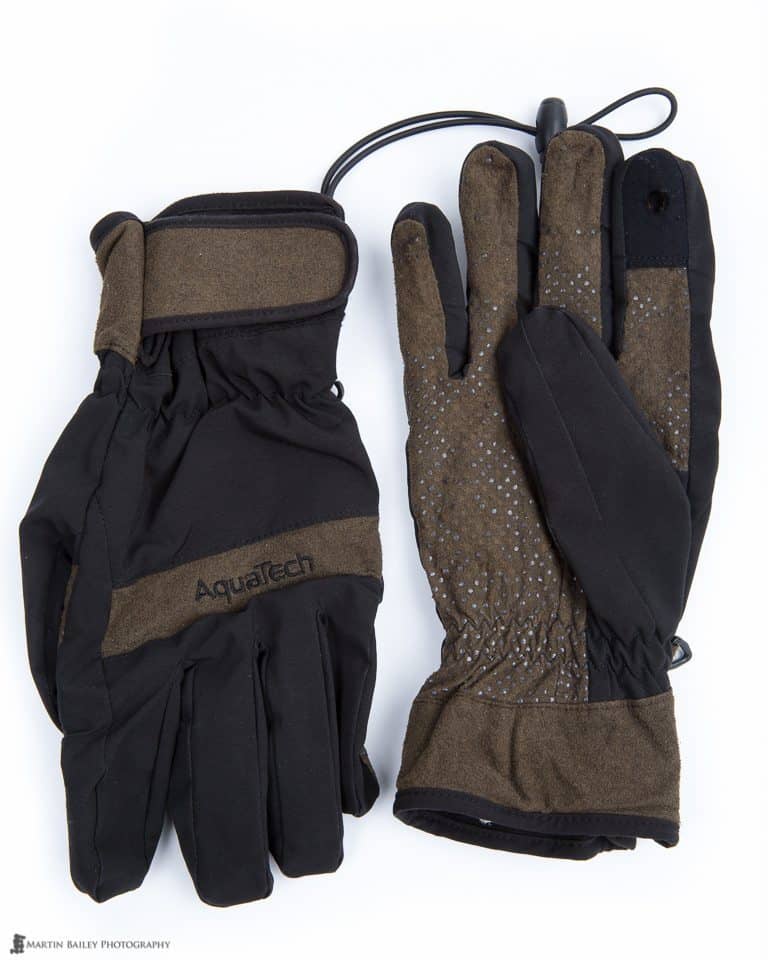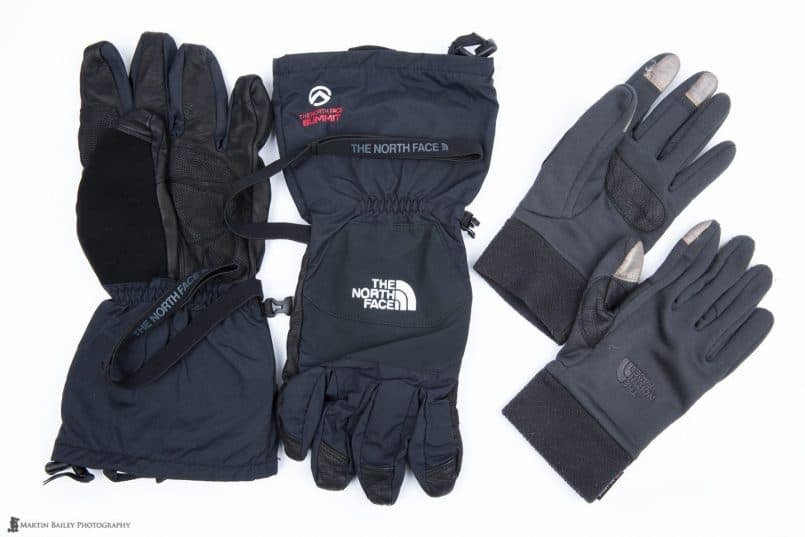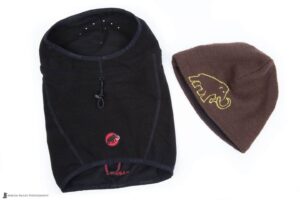With my Japan Snow Monkey and Hokkaido Photography Tour and Workshops for 2014 just around the corner, this week I’m going to walk you through the main items of clothing that I take with me. This of course is not solely for the purpose of my tour participants, although this will be of use to any of you joining me next year or in the future. My goal here is to help anyone preparing for a photography trip to sub-zero climbs.
Although I usually limit the number of photos I embed into an Enhance Podcast to 10, today we’re going to zip through 19 photographs, and 21 items of clothing or footwear.
Note that I have built up this collection of clothing over the last 10 years or so, so some of the things we will look at are no longer being manufactured. Also, because I do most of my shopping in Japan where I live, there are brands that are probably not going to be available where you live, unless you also live in Japan of course.
Apart from a few things for which I’ll include links, the idea here is not to point you to specific products, but rather to give you an idea of what you need to find for your own trip to the cold places. I will embed links where available, but otherwise please just use this as a guide.
Temperatures on my Japan Winter Wonderland Workshop range from around 5°C (41°F) on a warm day to as cold as -35°C (-31°F) at it’s coldest. On average, the dawn shoots are around -15°C to -20°C (5°F to -4°F) and then it creeps up to around freezing point during the day, and then cools down again by late afternoon.
To keep your feet warm you’ll want some nice thick socks. I use the ones photographed here from Paine (right), as they have lovely thick weave on the inside, trapping a lot of air, which of course helps to keep your feet warm. You can wear two pairs of thinner socks too, but these thick winter walking socks work very well for me. These are all I use.
We’ll look at boots last, and continue with the underwear theme here, and before you avert your, I’m not talking shreddies here (that’s British-English for underpants) I’m talking about thermal pants. Body Wild long-johns no-less!
I’m pretty sure that Body Wild is a Japanese English marketing thing, but this is quite a popular brand here in Japan. I have a number of these thinner long-johns, and a couple of thicker weave pairs for the really cold days, but I also regulate warmth with a few other types of pants too, that we’ll get too shortly.
One of the main things to bear in mind with winter clothing is to dress in layers. Of course, with pants it’s not so easy to take stuff off, so trying to have various options for the weather you expect to be in is important, and we’ll literally go through all of my options, but do bear in mind that you’ll rarely find a one-size-fits-all approach to winter clothing, and using layers really helps to regulate your heat. You might find that even in a single day you’ll be adding and removing layers throughout the day to stay comfortable.
I also use a mix of Body Wild and Paine undershirts. The Body Wild shirts are thinner, and warm, but again, for the really cold days, I have some thicker undershirts from Paine that help to keep me warm (Body Wild: below left and Paine: below right).
When the temperature is around freezing point, I generally wear the thin thermal long-johns, with these relatively thick rain pants from Mont Bell (below left). I really like these pants because they have a separate liner at the bottom of the legs that goes around your boot or even inside the top of your boot and prevents cold air from going up your legs, which really helps to keep you warm. These are waterproof too of course, which means you can sit in snow even as it melts, and not get wet.
When it goes much below freezing though, say when I expect it to be -15°C to -20°C (5°F to -4°F) at dawn, I generally reach for my down pants from Mountain Equipment (above right). These are fairly pricy, but incredibly warm when you need it. The good thing about down too though is if you need to keep these on as it warms up, you don’t overheat until it really starts to get warm.
I do wear the thermal underwear with these down pants, as they have a nylon inner that can be a bit chilly directly on the skin, but I doubt that they were designed to be warn without anything underneath.
Something else that I sometimes do too, is wear these fleece inner pants (left) under my Mont Bell rain pants. This combination is not quite as warm as my down pants, and again, working in layers, if necessary I can take off the rain pants and just wear the thermal long-johns and these fleece pants if it warms up too much during the day.
OK, so back to the upper body again, on top of my thermal undershirt, I generally wear a thin fleece, like this The North Face fleece that we see here (below left). This is pretty much unchanged for the entire trip. Hang on, let me rephrase that. I take a few of these and change them after a few days, but I generally always wear a thin fleece, and build on top of that depending on temperature.
On top of my thin fleece, I actually wear a thicker warmer fleece, because I generally use the Gitzo Photography Jacket that we’ll look at in a moment, and this jacket doesn’t provide a lot of warmth, so a thin fleece with a warmer fleece on top is my warmth. If it warms up during the day, I actually sometimes end up taking the Gitzo Jacket off, and work in just a fleece, such as the Mammut Fleece Lined Jacket that we see here (above center) or my nice furry Mont Bell fleece with the windproof liner (above right). Windproof liners in fleeces are great, and although I don’t necessarily want them in all of my fleeces, they really help to keep you warm when the wind gets up, especially if you don’t have a jacket on, on top of the fleece.
OK, so I’m including the Gitzo Four Season Photo Jacket here today (below left), because I’m still using it, but I have to tell you that I’ve never been fully happy with this Jacket. Firstly, it’s only really Four Season when you buy the optional fleece inner. Alone, this jacket should not carry the name four season.
Also, this thing is very heavy, and I’ve had to exchange zippers and have it repaired in a number of places through rips etc. Sure, I have taken this jacket around the world three times, and have given it hell, and apart from its shortcomings, it’s been good to me, so I shouldn’t complain, but I do think it could have been designed much better. I was hoping that Gitzo would release an updated version with better quality zips, and lighter material and design, but that hasn’t happened yet.
My recommended alternative to the Gitzo Jacket is a nice warm down jacket, like this Gore-Tex Down from Mello’s. This is what I wore for my first few years while visiting Hokkaido in winter, and it was lovely and warm. I still wear it now as a winter jacket, but of course because it’s not designed as a photographer’s jacket, it doesn’t have pockets that you can keep lenses in etc. like the Gitzo.
If you are going to wear a non-photography down jacket, I strongly recommend also using something like this photography vest too. This goes for all seasons. I really think that a photography vest helps you shoot, by keeping your lenses and accessories on hand, so you don’t have to take your backpack off every time you need something.
Something else to bear in mind is to try to avoid the canvas material vests. They are horrible when wet. Although we are generally dealing with snow rather than rain, it can rain on warm days, so your outer jacket needs to be waterproof, and if your photography vest is not made of quick drying nylon or other material, you need an outer jacket large enough to also go over your vest, maybe even with a lens or two in your pockets if possible.
Of course, if you do go for a down jacket, you also have to rethink the fleece strategy, because you don’t necessary need a thin fleece and a thick fleece as well as a down jacket all the time. This combination would be great for the dawn shoots when it’s very cold, but then during the day you’d likely remove the thicker fleece, and just go with the thin fleece and the down.
Again though, the good thing about dressing in layers like this, is that you have the freedom to do just that.
So, now that we’re all dressed up to keep warm, we need to keep our extremities warm too, so let’s look at some hats and gloves.
Until this year I used and still recommend the AquaTech Sensory Gloves (below left). These are great gloves that are warm enough for most conditions, but are not so bulky that you can’t use your camera. They also have an elasticated hole in the thumb and forefinger to that you can push your fingers through when you really need your dexterity, like when changing a CF Card in the field for example.
In extreme cold though, the Sensory Gloves are not quite as warm as I’d like, but they are just a tad too bulky to be able to pull on a pair of over-gloves for a bit of extra warmth, so for this year’s Winter Wonderland Tours I actually bought and used the two pairs of The North Face gloves that we see in this photo (above right). The thin pair of gloves are remarkably warm for their thickness, and they have little metalized panels on the thumb and first two fingers, so you can actually use them with an iPhone or other touch screen smart phone.
Also, because they are so thin, it’s easy to pull on the second larger pairs of gloves you see there when it gets really cold, and then you’re nice and toasty. I don’t use the outer-gloves that often, but if you end up standing around in sub-zero temperatures waiting for something to happen, then these can be the sort of creature comfort that makes a difference.
On the hat front, I currently use a Mammut beanie with a fleece lining (second from left), that I absolutely love. Beanies are great because they hug your head and don’t take up much room when you aren’t wearing them. I’ve started feeling the cold a little more over last few years though, and now also take this Mammut neck warmer with a face guard built into it (below left). This is good for just keeping around your neck, but then you can pull it up over your mouth and nose when it gets really cold.
Again, stepping back in time a little to when I first started visiting Hokkaido in the winter, I used to use this great mad-bomber hat. I actually still really like this hat, though I find it a bit too warm a lot of the time. If you like to stay cozy though, these are great hats. I bought mine online from Hartford York Hats, and although I can’t find this exact model any more, I’ll put a link into the show notes.
OK, so just a couple more things to cover now. I used a pair of leather Baffin winter boots for the last ten years, but they finally gave up the ghost at the end of last season, so I’ve just bought a new pair for the coming season. These are the Baffin Impact boots (right) and they are rated down to -100°C (-148°F).
Now, you might think that -100°C is overkill, but quite often ratings like this are stated based on the coldest you can go before it starts to get dangerous, and is often not directly linked to comfort. My old Baffin boots were rated down to -70°C (94°f) and although they were toasty most of the time, when it gets down below -15°C (5°C) or colder and you are standing around, you can still feel the cold, so -100°C won’t necessarily go to waste in the conditions we get.
These boots also have great grip for snow, but as we sometimes walk on icy surfaces, I also now recommend that the group bring some metal spikes or chains like these Kahtoola Spikes, that we see fitted to my new Baffin boots here (below).
Although these spikes were great, I did find that standing on spikes for a length of time in my old boots got a bit uncomfortable, and I’ve actually just ordered a new set of ICEtrekkers Diamond Grip chains instead. These are what David duChemin was able to get for the 2013 tour that he joined us for, and he was very happy with them.
A few other things that I wanted to mention before we finish are that although it’s cold, you generally also should bring sunscreen and sunglasses, as the snow can get really bright when the sun comes out, and also a lip balm stick and some hand cream is useful too. My fingers generally crack when I’ve been in cold conditions for a few days, so having some cream can help.
Also chemical hand-warmers can help too. For my Winter Wonderland Tour and Workshops we actually provide hand warmers, foot warmers and chemical warmers that you can stick to your clothing. Especially when you’re standing up all day in cold conditions, I find that sticking a warmer on my undershirt at the small of my back not only keeps me warm, but it helps with the aches that can develop, especially when you are carrying cameras etc. for extended periods too.
Do check with airlines if you intend to buy and carry these overseas yourself though. Some types of hand-warmer are not allowed on airplanes. This is one of the reasons that I provide these on my tours, to save participants from having to deal with this.
OK, so that’s about it. I know this isn’t going to be useful for everyone, but hopefully if you plan a shoot in the cold places in our corner of the solar system at some point, hopefully this will be a good reference for what you need to take with you.
Show Notes
AquaTech Sensor Gloves: https://mbp.ac/aqtsg
Hartford York Hats: http://www.hartfordyork.com/category/fur-hats
Music by UniqueTracks
Subscribe in iTunes for Enhanced Podcasts delivered automatically to your computer.
Download this Podcast in MP3 format (Audio Only).
Download this Podcast in Enhanced Podcast M4A format. This requires Apple iTunes or Quicktime to view/listen.






















Great stuff Martin. I wear a 10 1/2 sneaker (US) but have wide feet . As the Baffin boots do not come in widths do you think that I should get a size 11? Do you wear heavy socks with them?
thanks, artie
Hi Artie,
I usually take a 9 UK / 10 US size, but it felt just a bit too snug, so I went for the 10 UK / 11 US size and if anything they’re a tad too large, although trapping a bit of air is good to help keep warm. I have pretty wide feet too, so yes, I’d say go for the 11 and they’ll probably be perfect.
Yes, I wear the socks at the top of this post with them. They have a very thick weave inside too.
Thanks for dropping by!
Cheers,
Martin.
Thanks a stack Martin. I am wondering if I will wind up needing a 12….
Maybe so, but I was thinking that as you take a 1/2 size larger than me in a sneaker, and my size 11 (US) Baffins are just slightly on the large size, they might be perfect for you. I was able to put a pair of size 10 (US) on, but they were a tad too tight.
Of course it would be best if you could try them before you buy, but if you mail order, ensure you can send them back if necessary.
Thanks again Martin. I will try to mail order two pairs and return one 🙂 artie
I ordered a size 11. As expected, the boots are huge. But I could barely get my size 10 1/2 feet into them without socks on…. I am exchanging them for a size 12 and would not be shocked if they are too small as they are very narrow….. 🙂
Wow! That’s surprising. I usually take a 3E width shoe, and although they are snug, the US 10 were fine for me. Sorry about that Artie. I hope the 12s are good for you though.
Stumbled on this as looking for an alternative to my Paramo Pajaro jacket. Is the Gitzo waterproof though? I do music photography and normally running around so once I’ve arrived to location i normally empty my bag and put lenses into the pockets and pockets look sturdier. Can only find an XL and im a 5ft woman so on the fence a bit. Thoughts